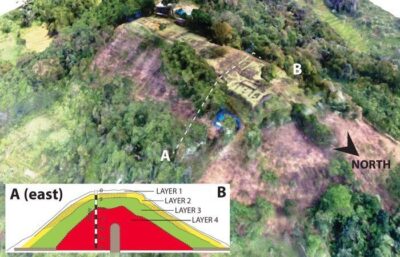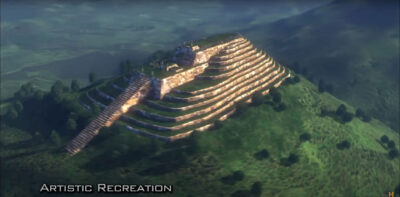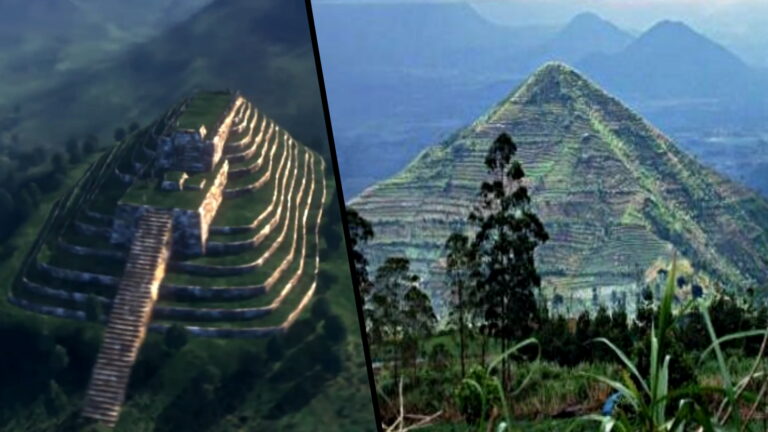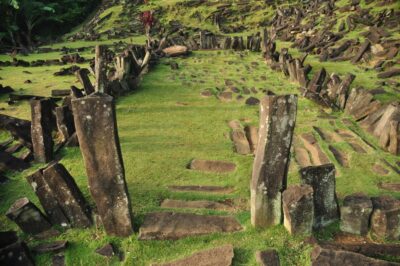The First Discovery of Gunung Padang
There have been numerous times throughout history when someone has made a discovery without recognizing the truly paradigm shifting nature of what they’d found. In 1914, something similar took place on the island of Java, Indonesia.
At that time, the country was a colony of the Dutch empire, and colonists dotted the island on farms cut out of the jungle. Early in the year, one such colonist decided to leave his farm and set out on foot into the surrounding jungle after hearing a story from locals about a lost palace constructed by a mythical king sometime long ago.
It did not take long for the colonist to come across something incredible. There, deep in the jungle, he discovered an enormous hill with what appeared to be a series of steps leading to its summit. At the top of these steps, he found a huge collection of heavy rectangular blocks scattered in every direction, long since overgrown with foliage. Could this be the remains of the mythical palace he had come looking for?
Returning to his farm, the colonist promptly sent a letter to the government of Holland describing his discovery and requesting a professional expedition to explore the site further. This description appeared in a 1914 edition of the Dutch ‘Report on the Department of Antiquities,’ causing quite a stir in the colonist’s home country. What was this site, many people wondered, and who built it? Furthermore, what was its purpose, and what else might be hidden under the ground?
Despite this interest, the Dutch government never did get around to sending an expedition to examine the site further. By 1949, Indonesia had fully gained its independence from Holland, and the site had faded from memory.
The Rediscovery of Gunung Padang
And there the story might have ended, if not for three local Java residents who rediscovered the site while wandering around in the jungle in 1979.
Coming across the mysterious hill’s graveyard of stone blocks, they quickly reported their finding to local officials, who identified the site as a hill known as Gunung Padang. Within weeks, the Indonesian government had dispatched teams from the Directorate for Heritage Protection and Management and the National Center of Archaeology to explore the site further.
In short order, researchers set about mapping the site and documenting its archaeological features. First there were the stone blocks which the Dutch colonist had come across all those years before, a near endless number of them, most about 5 feet in length and weighing upwards of 550lbs; some were much bigger, weighing over 1,300lbs.
Researchers quickly realized that these blocks were not made by humans, but rather naturally forming andesite rock forged by a volcano. This meant that somebody had transported them to the top of this hill, some 300 feet above the valley below. But who, and why?
As they continued their investigation, researchers discovered that the blocks were not scattered about randomly, but in fact, organized into rectangular stone enclosures and rock mounds. Whoever had brought them up there had used the blocks for construction. In fact, it appeared that five separate terraces covered the hill over an area of 3,000 square feet, all linked by an ascending staircase of 370 steps.
Instead of using radiocarbon dating to determine the age of the site, researchers used simple guesswork, estimating it to have been built somewhere between 2500-1500 BCE by measuring the chips on the blocks. Accordingly, they concluded that while the site was certainly interesting, it was nothing earth shattering, merely the remains of an ancient settlement not unlike so many others found all around the world.
And this was how Gunung Padang was remembered, until 2011, when everything changed …
Dr. Natawidjaja's Research of Gunung Padang
In his work as a senior geologist at the Indonesian Institute of Sciences, Danny Hilman Natawidjaja came across many interesting things. But nothing piqued his interest quite like the hill known as Gunung Padang.
It was the “peculiar” shape of the hill that got to him, the way it stood out from the adjacent landscape.
“It’s not like the surrounding topography, which is very much eroded. This looks very young. It looked artificial.”

At first, their findings were unremarkable. Initial radiocarbon dating done on soils underneath the stone blocks at the surface produced dates of 1500-500 BCE, similar to the original estimate done in 1979. But as the team began to dig deeper, what they found shocked them.
Using tubular drills that brought up cores of earth and stone, they quickly obtained evidence of numerous human-made structures buried beneath the surface. More astonishingly, the deeper they went, the older the material they brought up became.
Beneath the surface, researchers found three distinct layers. While the first was only 2,500-3,500 years old, as they had initially determined, the second layer, about 10 feet below the surface, was dated at some 7,500-8,300 years old, and the third, nearly 50 feet down, at as much as 28,000 years old.
How could this be possible? Even at 7,500 years, this would date the site at 3,000 years before the ancient Sumerians, and 4,500 years before the ancient Egyptians. And at 28,000 years old, well, that was something else entirely, something before the last Ice Age, many thousands of years before human civilization is said to have existed.
Quickly, the team expanded their research, utilizing ground penetrating radar and seismic tomography to more extensively map what was buried under their feet. Doing so, they discovered that the second layer contained another arrangement of rectangular blocks, organized in a matrix structure, while the third layer contained additional rock structures, including what appeared to be large underground cavities and chambers.
It seemed that the blocks on the surface were only the start of Gunung Padang’s construction. As one geologist on the team put it, “what is previously seen as just surface building, it’s going down – and it’s a huge structure.”
Natawidjaja and his team reiterated this in a report they released on their findings, declaring,
“Our studies prove that the structure does not cover just the top but also wrap around the slopes covering about 15 hectares are at least. The structures are not only superficial but rooted into greater depth.In fact, its exposure clearly shows that the youngest construction is built on top of an older, more sophisticated cultural rock layer.”
In other words, Gunung Padang was not a hill at all, but rather, a sort of terraced pyramid, a series of layers built up over history, one settlement on top of another, thousands, or tens of thousands, of years into the past.

Was this possible? And if so, who was building this type of construction that far in the past, before modern science tells us human civilization even officially began? Could Gunung Padang really contain a record of the oldest civilization ever found, a discovery which would totally rewrite the history books?
Natawidjaja believed he had an answer.
“The geophysical evidence is unambiguous. Gunung Padang is not a natural hill, but a man-made pyramid and the origins of construction here go back long before the end of the last Ice Age. Since the work is massive even at the deepest levels, and bears witness to the kinds of sophisticated construction skills that were deployed to build the pyramids of Egypt or the largest megalithic sites of Europe, I can only conclude that we’re looking at the work of a lost civilization.”
“It’s crazy, but it’s data.”
With the potential of a world changing discovery on their soil, the Indonesian government immediately jumped on board, pouring money into the project and lavishing researchers with state-of-the-art equipment, while calling up members of the Indonesian military to help with excavation. The country’s president, Susilo Bambang Yudhoyono, called the work at Gunung Padang “of important value for humanity,” and even had a helipad built at the top of the hill so he could visit and see the progress for himself.
The Suppression of the Gunung Padang Pyramid
And yet, it was not all positive for Natawidjaja and his research team.
Because their discovery was so groundbreaking, it quickly became the subject of much controversy. That history was being rewritten was, as Natawidjaja described, “not at all what my colleagues in the world of archaeology expected or wanted to hear.”
Almost instantly, the archaeological establishment in Indonesia lined up in opposition. They lobbied political authorities and agitated locally, demanding that the project be stopped. On the surface, their criticism was of the team’s methods and findings, allegations that proper excavation procedures were not being followed and results were being constructed based on biased interpretations. They also complained about the large budget which had been devoted to the project, contending that they needed the money for their own, more important, work.
But as time passed, the true nature of their opposition became clear.
Despite having conducted no research of their own, the archaeological establishment asserted that they ‘knew’ the remains at Gunung Padang could not be older than 5,000 years simply because it was illogical to suggest that a civilization existed that far in the past; it could not be possible, because if it was, it would challenge the records of human civilization contained within the history books. In other words, their true problem was that they were unwilling to adjust their thinking, unable to consider that what they knew about human history might be wrong.
Natawidjaja was under no illusions about the forces he was up against. “I’ve already got myself into a lot of hot water with this,” he explained. “My case is a solid one, based on good scientific evidence, but it’s not an easy one. I’m up against deeply entrenched beliefs.”
To his critics, he proclaimed,
“I don’t deny that the megaliths at the surface are less than 5,000 years old. But I suggest they were put here because Gunung Padang has been recognized as a sacred place since time immemorial. It’s the deepest layers of the structure at between 12,000 and more than 20,000 years old that are the most important. They have potentially revolutionary implications for our understanding of history, and I think it’s vital that we be allowed to investigate them properly.”
The government of Indonesia agreed. Despite vigorous opposition, research at Gunung Padang continued with government support, and as it did, the discoveries got even more amazing.
As the jungle got cleared away to facilitate excavation, researchers uncovered numerous relics all throughout the area – jewelry and ceramics, tools and household goods, weapons. They even uncovered never-before-seen coins which they dated to 5200 BCE, an astonishing date since modern science insisted that the world’s first coins appeared around 600 BCE.
Further, they discovered that the cement mixture used to hold the giant blocks of Gunung Padang together was composed of a combination of clay, silica … and iron. This suggested that iron-melting technology had been known about many thousands of years in the past, impossible, according to mainstream science, since the Iron Age didn’t start until 1201 BCE.
But there was more than that. As Natawidjaja and his team continued to work, another group of scientists arrived determined to examine something else they’d heard about. According to local legend, the blocks at Gunung Padang give off a kind of mysterious energy, making it a place where, for as long as anyone could remember, people traveled to meditate. In fact, Gunung Padang in the ancient local language means “Mountain of Enlightenment.” Was there any truth to this legend?
Studying the idea further using modern equipment, researchers found that indeed the blocks emitted a “relatively high frequency,” at levels which, curiously, “have correspondence with the standard western musical scale.”
We have explored the secrets of frequency and vibration in detail on this channel, from Greek philosopher Pythagoras and his vibrational medicine to the acoustic levitation of Buddhist monks, to Nikola Tesla and his famous words: “If you want to know the secrets of the Universe, think in terms of energy, frequency and vibration.“
The unusual frequencies produced by the blocks at Gunung Padang seemed to suggest that its builders knew about these secrets many thousands of years in the past, secrets which still allude us today.
Coins before coins, iron before the Iron Age, secrets of frequency and vibration that we still don’t understand – it seemed the Gunung Padang was not just proof of an extremely old civilization, but, as Natawidjaja put it, “proof of an intelligent and extremely advanced civilization.” Could it be, as Natawidjaja asserted, that “everything we’ve been taught about the origins of civilization may be wrong.”
The answer to this question never came. At the climax of a discovery set to change our understanding of human history, disaster struck for Natawidjaja and his team.
In 2014, Susilo Bambang Yudhoyono’s second term as President of Indonesia, the maximum allowed under the constitution of the country, came to an end, and Joko Widodo was elected as his replacement. Unlike his predecessor, Widodo sided with the archaeological establishment on the issue of Gunung Padang. On October 1, 2014, research at the site was halted, Natawidjaja and his team told to pack up and go home, to forget their work which appeared so crucial, so groundbreaking. To this day, Widodo remains president, and research at Gunung Padang remains shut down, the mystery unsolved, history, incomplete.
Could an advanced ancient civilization really have existed thousands of years before the ancient Egyptians or Sumerians, before even the last Ice Age? And if so, who were they, and what happened to them?
What if they were part of a lost continent home of an advanced civilization? Check our article on Lemuria and Mu to learn more.


